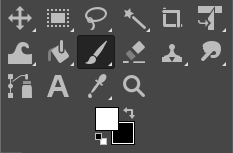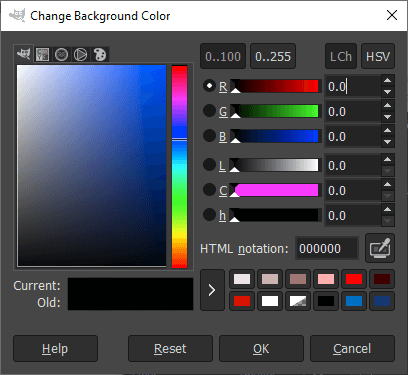How To Change Brush Color In Paint.net
The first fourth dimension you open a new image editing program, there's ever a huge number of things to learn. Even if y'all've only used a few other editing programs before, there are some common interface pattern decisions that experience immediately familiar.
Merely what about the very commencement time you ever use any kind of image editing program?
If you've never opened GIMP earlier, you lot might feel a bit overwhelmed when you realize how much at that place is to acquire – just don't stress yourself, TheGimpTutorials.com has yous covered! Changing your paintbrush color is very easy, once you know how information technology works and where to look.
Locate the toolbox console, which is usually located in the upper left corner of the GIMP window past default. Yours might be scaled a flake differently than the example shown below, but the basic principle is the same.

The icons permit you to quickly switch between GIMP'due south diverse editing tools. The two colored squares beneath, currently showing white and black, indicate your currently selected foreground color (white, in this example) and background colour (black, in this instance).
You tin change your foreground colour by clicking the foursquare in the upper left (the white one, in the image above). GIMP will open a complete picker window, providing a wide range of options for selecting a new foreground color.

Use the color spectrum to choose a hue, and so fix the saturation and value using the larger colour surface area. The Current: section will adapt to prove the currently selected colour.
You'll notice that there is a row of pocket-size icons above the large colour picker area, which provides a few unlike interactive means to select your new color. Feel free to experiment with these until you lot find ane that yous're happy with, although some of them can be quite confusing at beginning and it'due south simplest to stick with the GIMP default.
It's besides possible to select a color by entering specific RGB or Lch values on the correct side of the colour picker window. You can even select a colour using the hex color codes used in website development, which is perfect if yous're trying to color-match with an existing design.

The exact same procedure applies for selecting your groundwork colour, except that you starting time past clicking the other colored square beneath the toolbox area, shown as black in the instance above.

You'll note that the color picker window indicates that you're choosing the background color in the title bar instead of the foreground color, in case you get mixed up.

If you want to render your foreground and groundwork colors to the default black and white setting, you tin can click the modest black and white square icons in the lesser left of the color display expanse. You lot tin also swap your foreground and groundwork colors past clicking the small-scale two-headed arrow icon in the upper right of the color display expanse.
These colors are used by GIMP in a number of different situations, including erasing, gradients, and more, so it's a good idea to go familiar with setting them up the way y'all desire!
My Paintbrush Colour Doesn't Match!
If yous have followed the steps to a higher place and y'all however tin't modify your paintbrush color, it's possible that the image you're working on is set to a specific color mode that is preventing you from using your selected Paintbrush color.
The vast bulk of digital images utilize the RGB color mode, which combines three color channels – Reddish, Green, and Blue – to make whatsoever color your eye can run across. There are really several more mutual modes such equally LaB, CMYK, Indexed, and Grayscale mode., just GIMP only supports RGB, Grayscale, and Indexed modes at the moment.
Indexed way is typically used in GIF images as a way of reducing the bachelor color data in an image as a way of reducing file size, and Grayscale does exactly what it says on the tin: purely grayscale images, amend known to most people as black and white images.
If your epitome is gear up to grayscale fashion, your colour picker will work exactly the way I explained before, except when you actually start to use the Paintbrush, you'll only be able to paint with the shade of gray that corresponds to the value of your called colour.
I'm not certain why GIMP doesn't betoken your color mode while really using the color picker, but there'south probably a good reason for it – though the choice to customize the display would be squeamish.

To switch your colour fashion, open up the Image bill of fare, select the Mode submenu, and click RGB. In one case you're in RGB mode, you should be able to paint with your selected color anywhere on the canvas.
That covers everything that you demand to know about how to change paintbrush colors in GIMP! If y'all're still having a problem, drop me a message in the comments department below and I'll see what I tin can practice to help.
Source: https://thegimptutorials.com/how-to-change-paintbrush-color/
Posted by: baileythoseltogs.blogspot.com

0 Response to "How To Change Brush Color In Paint.net"
Post a Comment